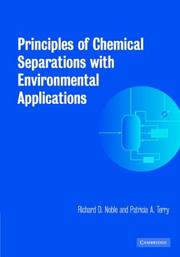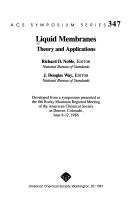| Listing 1 - 10 of 10 |
Sort by
|
Book
ISBN: 9780854881628 9780262640695 085488162X 0262640694 Year: 2009 Volume: *3 Publisher: London Whitechapel
Abstract | Keywords | Export | Availability | Bookmark
 Loading...
Loading...Choose an application
- Reference Manager
- EndNote
- RefWorks (Direct export to RefWorks)
Utopian strategies in contemporary art seen in the context of the histories of utopian thinking and avant-garde art. Throughout its diverse manifestations, the utopian entails two related but contradictory elements: the aspiration to a better world, and the acknowledgement that its form may only ever live in our imaginations. Furthermore, we are as haunted by the failures of utopian enterprise as we are inspired by the desire to repair the failed and build the new. Contemporary art reflects this general ambivalence. The utopian impulse informs politically activist and relational art, practices that fuse elements of art, design, and architecture, and collaborative projects aspiring to progressive social or political change. Two other tendencies have emerged in recent art: a looking backward to investigate the utopian elements of previous eras, and the imaginative modeling of alternative worlds as intimations of possibility. This anthology contextualizes these utopian currents in relation to political thought, viewing the utopian as a key term in the artistic lineage of modernity. It illuminates how the exploration of utopian themes in art today contributes to our understanding of contemporary cultures, and the possibilities for shaping their futures.
hedendaagse kunst --- art theory --- utopias --- thema's in de kunst --- dystopias --- art [fine art] --- Art --- Contemporary [style of art] --- Parreno, Philippe --- Tiravanija, Rirkrit --- Young, Carey --- Gillick, Liam --- Graham, Dan --- McCarthy, Paul --- Titchner, Mark --- Kabakov, Ilija Iosefovich --- Beuys, Joseph --- Pil & Galia Kollectiv --- Constant --- Noble, Paul --- Gormley, Antony --- Norman, Nils --- Chan, Paul --- Kingelez, Bodys Isek --- Hirschhorn, Thomas --- Debord, Guy --- Deller, Jeremy --- Wochenklausur --- Atelier Van Lieshout [Rotterdam] --- Superflex [Copenhagen] --- anno 2000-2099 --- anno 1900-1999 --- Art, Modern --- Utopias in art --- Art and society --- Utopies dans l'art --- Art et société --- History --- Histoire --- Utopias in art. --- 7.01 --- Kunst ; theorie, filosofie, esthetica --- Kunsttheorie ; utopieën ; 20ste en 21ste eeuw --- Art et société --- Contemporary art --- Modernism (Art) --- Affichistes (Group of artists) --- Fluxus (Group of artists) --- Schule der Neuen Prächtigkeit (Group of artists) --- Zero (Group of artists) --- Art and sociology --- Society and art --- Sociology and art --- Social aspects --- Utopie --- Imaginaire --- Art et politique --- Iconographie --- Art contemporain --- Processus de création --- Psychologie --- Création artistique --- Psychanalyse --- Psychanalyse et art --- Psychologie et art --- Kunst --- kunst --- utopia's --- kunsttheorie --- dystopieën --- SUPERFLEX [Kopenhagen] --- SUPERFLEX [Copenhagen] --- utopie --- land art --- kunst en politiek --- performances --- happenings --- activisme --- situationisme --- 130.2 --- 7.039 --- kunst en ecologie --- 7.038/039 --- 7.038 --- cultuurfilosofie --- twintigste eeuw --- eenentwintigste eeuw --- Art, Modern - 20th century --- Art, Modern - 21st century --- Art and society - History - 20th century --- Art and society - History - 21st century --- art [discipline] --- Futurisme
Book
ISBN: 9780367183387 9780429060892 0429060890 9780367183400 9780429593789 0429593783 9780429595073 0429595077 9780429592492 0429592493 0367183382 Year: 2020 Publisher: London : Routledge,
Abstract | Keywords | Export | Availability | Bookmark
 Loading...
Loading...Choose an application
- Reference Manager
- EndNote
- RefWorks (Direct export to RefWorks)
Book
Year: 1713 Publisher: London : Printed for Samuel Keble, at the Turk's-Head in Fleetstreet, and sold by John Morphew near Stationers-hall,
Abstract | Keywords | Export | Availability | Bookmark
 Loading...
Loading...Choose an application
- Reference Manager
- EndNote
- RefWorks (Direct export to RefWorks)
eebo-0018
Trials (Murder) --- Last words --- Noble, Richard,
Book
Year: 1713 Publisher: London : Printed for Bernard Lintott, at the Cross-Keys between the Two Temple-Gate, Fleet-street,
Abstract | Keywords | Export | Availability | Bookmark
 Loading...
Loading...Choose an application
- Reference Manager
- EndNote
- RefWorks (Direct export to RefWorks)
eebo-0018
Book
ISBN: 9783775748230 Year: 2021 Publisher: Berlin Hatje Cantz
Abstract | Keywords | Export | Availability | Bookmark
 Loading...
Loading...Choose an application
- Reference Manager
- EndNote
- RefWorks (Direct export to RefWorks)
Can a sculpture be a river? Can contemporary art unite conflicting systems of belief? Do other species appreciate culture? And can public art revive communities and ecosystems? Cristina Iglesias’ horizontal fountains, submerged rooms and tropical mazes bring together language, architecture and botany to create immersive spaces of contemplation. In this publication an international roster of curators, art critics, philosophers, architects and scientists discuss the social and ecological potential of art in urban and rural space. Spanish artist CRISTINA IGLESIAS (*1956) creates profound spaces of the imagination. Renowned for her sculptures woven, cast or constructed from metal, wood and alabaster, Iglesias also creates outdoor structures and installations using water. Her work can be found in inner cities or remote islands, as a site of pilgrimage for humans or as a habitat for animals.
Sculpture --- sculpture [visual works] --- outdoor sculpture --- public art --- studies [visual works] --- environmental art --- marine environments --- metal --- water [inorganic material] --- Iglesias, Cristina

ISBN: 052181152X 0521010144 Year: 2004 Publisher: Cambridge Cambridge University press
Abstract | Keywords | Export | Availability | Bookmark
 Loading...
Loading...Choose an application
- Reference Manager
- EndNote
- RefWorks (Direct export to RefWorks)
This introduction to chemical separations technology presents the chemical and/or physical basis of different techniques and explains how to evaluate them for design and analysis. Chemical separations are of central importance in many areas of environmental science, whether it is cleaning up polluted water or soil, the treatment of discharge streams from chemical processes, or modification of a specific process to decrease its environmental impact. This textbook is suitable for undergraduate and graduate students taking courses on environmental separations or environmental engineering. Many worked examples and over 100 homework problems are key highlights.
#KVIV:BB --- Environmental chemistry. --- Environmental management. --- Separation (Technology) --- Environmental Sciences and Forestry. Environmental Management --- Environmental Management (General) --- Separation (Technology). --- Environmental Management (General). --- Environmental chemistry --- Environmental management --- Chemistry, Analytic --- Chemistry, Technical --- Technology --- Environmental stewardship --- Stewardship, Environmental --- Environmental sciences --- Management --- Chemistry, Environmental --- Chemistry --- Ecology --- Analytical chemistry --- Chemical separations --- Separation processes --- Separation science --- Separation technologies --- Separations, Chemical
Book
ISBN: 0863555101 Year: 2003 Publisher: London The British Council
Abstract | Keywords | Export | Availability | Bookmark
 Loading...
Loading...Choose an application
- Reference Manager
- EndNote
- RefWorks (Direct export to RefWorks)

ISBN: 0841214077 Year: 1987
Abstract | Keywords | Export | Availability | Bookmark
 Loading...
Loading...Choose an application
- Reference Manager
- EndNote
- RefWorks (Direct export to RefWorks)
Book
Abstract | Keywords | Export | Availability | Bookmark
 Loading...
Loading...Choose an application
- Reference Manager
- EndNote
- RefWorks (Direct export to RefWorks)
Book

Year: 2003 Publisher: New York (N.Y.) Privately printed
Abstract | Keywords | Export | Availability | Bookmark
 Loading...
Loading...Choose an application
- Reference Manager
- EndNote
- RefWorks (Direct export to RefWorks)
| Listing 1 - 10 of 10 |
Sort by
|

 Search
Search Feedback
Feedback About UniCat
About UniCat  Help
Help News
News